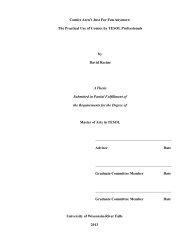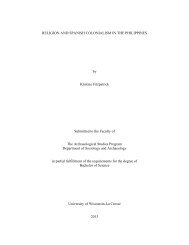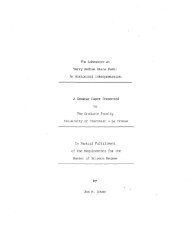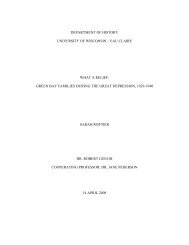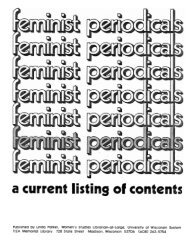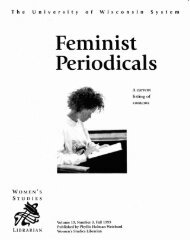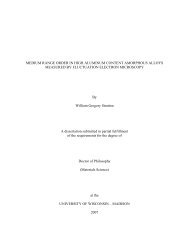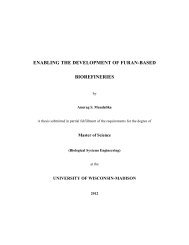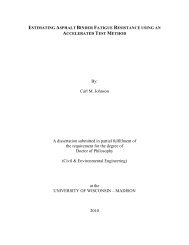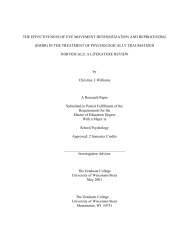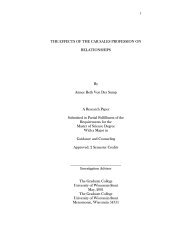1 CONFRONTS THE TEXTBOOK.. - MINDS@UW Home - University ...
1 CONFRONTS THE TEXTBOOK.. - MINDS@UW Home - University ...
1 CONFRONTS THE TEXTBOOK.. - MINDS@UW Home - University ...
You also want an ePaper? Increase the reach of your titles
YUMPU automatically turns print PDFs into web optimized ePapers that Google loves.
Page 10 Feminist Collec(iom v.16.m.l. FSII 1994<br />
Austen, Susanna Centlivre, Hannah Cowley, and Ada<br />
Leverson.) Most articles are concerned with comedy in<br />
the sense of the dramatic genre, rather than comedy as<br />
laughter. The critics, using a variety of methodologies,<br />
examine the question of how to mesh subversive repre-<br />
sentations of gender and sexuality with the need of tradi-<br />
tional comedy to end in a vision of social integration.<br />
Q: What do lesbians do in bed?<br />
A: It's a lot like heterosexual sex, only one of<br />
us doesn't have to fake orgasm.<br />
-- Suzanne Westenhoefer<br />
(from Glibquips)<br />
The second section focuses on fiction and many of<br />
the articles investigate the relationship between laughter<br />
and genre (e.g., detective fiction, domestic humor, avant-<br />
garde modernism, etc.) Authors discussed are William<br />
Thackeray, George Meredith, Margaret Oliphant, James<br />
Joyce, Dorothy Richardson, Zora Neale Hurston, Evelyn<br />
Waugh, Marghanita Laski, Beryl Bainbridge, Sara<br />
Paretsky, Mary Roberts Rinem Alice Childress, and<br />
Vuginia WooK<br />
Section III analyzes film, stand-up comedy, and car-<br />
toon art. These articles, the topics of which range from<br />
Mae West to the genre of Hollywood screwball comedies<br />
to Pedro Almodovar, emphasize the performative and<br />
visual aspects of humor and its relationship to identity.<br />
What I like most about took Who's Laughing, in<br />
addition to the emphasis on historical specificity, is the<br />
variety of conclusions made about the uses of female<br />
laughter. Unlike many earlier volumes on women's humor,<br />
which imply Mrhaps inadvertently) that female<br />
laughter is invariably subversive, many of these writers<br />
question that assumption. For example, Kristin Bluemel<br />
concludes that the comic potential of Dorothy Richardson<br />
is limited by a contradiction between feminist content<br />
and feminist form, while Barbara Monroe points out some<br />
- -<br />
of the more troubling ascects of Zora Neale Hurston's<br />
comedy, such as her uncritical portrayals of domestic vie<br />
lence. Though I do not wish to downplay the powerfully<br />
subversive potential of female humor, I also appreciate<br />
this collection's more realistic assessment of the varia-<br />
tions of comic effect.<br />
The project of Frances Gray's Women and Laughter,<br />
her study of television situation comedy and female stand-<br />
up comedy in England and the U.S., is to reconstruct a<br />
female history of performance comedy. Rejecting the<br />
traditional theories of humor (relief, disparagement, ccl-<br />
ebration, and incongruity), she prefers instead the in-<br />
sights of Helene Cixous's "Laughter of the Medusa."<br />
Emphasizing laughter's potential to explode and destroy<br />
hierarchies, Gray argues that being a female performance<br />
comedian is an anarchic act which can "shatter the hue-<br />
work of institutions. . . blow up the law. . . break up the<br />
truth with laughter" (p.37).<br />
After her theoretical investigation of laughter, Gray<br />
mwes on in Section I1 to examine situation comedy in<br />
England and the U.S. By analyzing the complex and shift-<br />
ing relationships between the genre of sitcom, its cre-<br />
ators, and its consumers, she anives at some interesting<br />
and sometimes unexpected conclusions. For example,<br />
she argues that in the U.S., the 1950's produced more<br />
subversivecomic performances by women such as Lucille<br />
Ball and Gracie Allen than did the supposedly more lib-<br />
erated 1960's, with the containment of female power in<br />
shows such as Bewitched and I Dream ofJeunnie.<br />
In Part HI, Gray turns to the genre of stand-up com-<br />
edy. Examining the historical evolution of the genre from<br />
the 19th century music hall to the present day one-woman<br />
shows, Gray argues that stand-up comedy is a form of<br />
women's autobiography, a way to reinvent the selfthrough<br />
comic interaction with the audience.<br />
One of my friends tole me she was in labor for<br />
thirty-six hours. I don't even want to do anything<br />
that feels good for thirty-six hours.<br />
- Rita Rudner<br />
(from Glibquips)<br />
Because Frances Gray (who resides in England) is a<br />
playwright as well as a lecturer in drama, she brings a<br />
performance-oriented perspective to the field of women's<br />
comedy. Although I'm not sure that I agree with all of<br />
her points, such as her argument that stand-up comedy<br />
is inherently more transgressive than humorous writing,<br />
her analysis is rigorous, insightful and elegantly writ-<br />
ten. Feminists interested in popular culture andfor fe-<br />
male performance artists will definitely want to read this<br />
book.



